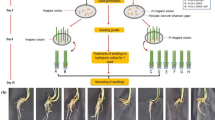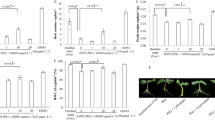Abstract
In the present study, we investigated the role of glucose-6-phosphate dehydrogenase (G6PDH) in regulating the levels of reduced form of glutathione (GSH) to the tolerance of calli from two reed ecotypes, Phragmites communis Trin. dune reed (DR) and swamp reed (SR), in a long-term salt stress. G6PDH activity was higher in SR callus than that of DR callus under 50–150 mM NaCl treatments. In contrast, at higher NaCl concentrations (300–600 mM), G6PDH activity was lower in SR callus. A similar profile was observed in GSH contents, glutathione reductase (GR) and glutathione peroxidase (GPX) activities in both salt-stressed calli. After G6PDH activity and expression were reduced in glycerol treatments, GSH contents and GR and GPX activity decreased strongly in both calli. Simultaneously, NaCl-induced hydrogen peroxide (H2O2) accumulation was also abolished. Exogenous application of H2O2 increased G6PDH, GR, and GPX activities and GSH contents in the control conditions and glycerol treatment. Diphenylene iodonium (DPI), a plasma membrane (PM) NADPH oxidase inhibitor, which counteracted NaCl-induced H2O2 accumulation, decreased these enzymes activities and GSH contents. Furthermore, exogenous application of H2O2 abolished the N-acetyl-l-cysteine (NAC)-induced decrease in G6PDH activity, and DPI suppressed the effect of buthionine sulfoximine (BSO) on induction of G6PDH activity. Western-blot analyses showed that G6PDH expression was stimulated by NaCl and H2O2, and blocked by DPI in DR callus. Taken together, G6PDH activity involved in GSH maintenance and H2O2 accumulation under salt stress. And H2O2 regulated G6PDH, GR, and GPX activities to maintain GSH levels. In the process, G6PDH plays a central role.











Similar content being viewed by others

Abbreviations
- BSO:
-
Buthionine sulfoximine
- DPI:
-
Diphenylene iodonium
- DR:
-
Dune reed
- DW:
-
Dry weight
- G6PDH:
-
Glucose-6-phosphate dehydrogenase
- GPX:
-
Glutathione peroxidase
- GR:
-
Glutathione reductase
- GSH:
-
Reduced glutathione
- GSSG:
-
Oxidative glutathione
- H2O2 :
-
Hydrogen peroxide
- NAC:
-
N-acetyl-l-cysteine
- PM:
-
Plasma membrane
- ROS:
-
Reactive oxygen species
- SR:
-
Swamp reed
References
Anderson JV, Chevone BI, Hess JL (1992) Seasonal variation in the antioxidant system of eastern white pine needles. Plant Physiol 98:501–508
Apel K, Hirt H (2004) Reactive oxygen species: metabolism, oxidative stress, and signal transduction. Annu Rev Plant Biol 55:373–399
Athar M, Iqbal M (1998) Ferric nitrilotriacetate promotes N-diethylnitrosamine-induced renal tumorigenesis in the rat: implications for the involvement of oxidative stress. Carcinogenesis 19:1133–1139
Aubert S, Gout E, Bligny R, Douce R (1994) Multiple effects of glycerol on plant cell metabolism. J Biol Chem 269:21420–21427
Auh CK, Murphy TM (1995) Plasma membrane redox enzyme is involved in the synthesis of O ·−2 and H2O2 by phytophthora elicitor-stimulated rose cells. Plant Physiol 107:1241–1247
Bartosz G (1997) Oxidative stress in plants. Acta Physiol Plant 19:47–64
Boyer JS (1982) Plant productivity and environment. Science 218:443–448
Bradford MM (1976) A rapid and sensitive method for the quantitation of microgram quantities of protein utilizing the principle of protein-dye binding. Anal Biochem 72:248–254
Carpita N, McCann M, Griffing LR (1996) The plant extra-cellular matrix: news from the cell’s frontier. Plant Cell 8:1451–1463
Cui SX, Wang W, Zhang CL (2002) Plant generation from callus cultures in two ecotypes of reed (Phramites communis Trinius). In Vitro Cell Dev Biol Plant 38:325–329
Cui SX, Zhao LQ, Zhao MG, He WL, Bi YR (2005) The tolerance of Embryogenic suspension cultures from two reed ecotypes to salt—changes of respiration pathway. Isr J Plant Sci 53:11–18
Dat J, Vandenabeele S, Vranova E, Van MM, Inze D, Van BF (2000) Dual action of the active oxygen species during plant stress responses. Cell Mol Life Sci 57:779–795
Davletova S, Rizhsky L, liang H, Shengqiang Z, Oliver DJ, Coutu J, Shulaev V, Schlauch K, Mittler R (2005) Cytosolic ascorbate peroxidase 1 is a central component of the reactive oxygen gene network of Arabidopsis. Plant Cell 17:268–281
Dutilleul C, Garmier M, Noctor G, Mathieu C, Chétrit P, Foyer CH, Paepe Rd (2003) Leaf mitochondria modulate whole cell redox homeostasis, set antioxidant capacity, and determine stress resistance through altered signaling and diurnal regulation. Plant Cell 15:1212–1226
Eshdat Y, Holland D, Faltin Z, BenHayyim G (1997) Plant glutathione peroxidase. Physiol Plant 100:234–240
Esposito S, Carfagna S, Massaro G, Vona V, Di MRV (2001) Glucose-6-phosphate dehydrogenase in barley roots: kinetic properties and localization of the isoforms. Planta 212:627–634
Fahrendorf T, Ni W, Shorrosh BS, Dixon RA (1995) Stress responses in alfalfa (Medicago sativa L.) XIX. Transcriptional activation of oxidative pentose phosphate pathway genes at the onset of the isoflavonoid phytoalexin response. Plant Mol Biol 28:885–900
Foyer CH, Halliwell B (1976) The presence of glutathione and glutathione reductase in chloroplast: a proposed role in ascorbic acid metabolism. Planta 133:21–25
Foyer CH, Noctor G (2000) Oxygen processing in photosynthesis: regulation and signalling. New Phytol 146:359–388
Foyer CH, Noctor G (2005a) Redox homeostasis and antioxidant signaling: a metabolic interface between stress perception and physiological responses. Plant Cell 17:1866–1875
Foyer CH, Noctor G (2005b) Oxidant and antioxidant signaling in plants: a re-evaluation of the concept of oxidative stress in a physiological context. Plant Cell Environ 28:1056–1071
Foyer CH, Souriau N, Perret S, Lelandais M, Kunert KJ (1995) Overexpression of glutathione reductase but not glutathione synthetase leads to increases in antioxidant capacity and resistance to photoinhibition in poplar trees. Plant Physiol 109:1047–1057
Fridovich I (1986) Biological effects of the superoxide radical. Arch Biochem Biophys 247:1–11
Hasegawa PM, Bressan RA, Zhu JK, Bohnert HJ (2000) Plant cellular and molecular responses to high salinity. Annu Rev Plant Mol Plant Physiol 51:463–499
Hernández JA, Ferrer MA, Jiménez A, Barceló AR, Sevilla F (2001) Antioxidant systems and O ·−2 /H2O2 production in the apoplast of pea leaves. Its relation with salt-induced necrotic lesions in minor veins. Plant Physiol 127:817–831
Hernández JA, Olmos E, Corpas FJ, Sevilla F, del Río LA (1995) Salt-induced oxidative stress in chloroplasts of pea plants. Plant Sci 105:151–167
Heyser JW, Nabors MW (1981) Osmotic adjustment of cultured tobacco cells (Nicotiana tabacum var. Samsun) grown on sodium chloride. Plant Physiol 67:720–727
Kletzien RF, Harris PKW, Foellmi LA (1994) Glucose-6-phosphate dehydrogenase: a “housekeeping” enzyme subject to tissue-specific regulation by hormones, nutrients, and oxidant stress. FASEB J 8:174–181
Kühn H, Borchert A (2002) Regulation of enzymatic lipid peroxidation: the interplay of peroxidizing and peroxide reducing enzymes. Free Rad Biol Med 33:154–172
Laemmli UK (1970) Cleavage of structural proteins during the assembly of the head of bacteriophage T4. Nature 227:680–685
Leisinger U, Rüfenacht K, Fischer B, Pesaro M, Spengler A, Zehnder AJB, Eggen RIL (2001) The glutathione peroxidase homologous gene from Chlamydomonas reinhardtii is transcriptionally up-regulated by singlet oxygen. Plant Mol Biol 46:395–408
Levine A, Tenhaken R, Dixon R, Lamb C (1994) H2O2 from the oxidative burst orchestrates the plant hypersensitive disease resistance response. Cell 79:583–593
Meister A (1994) Glutathione-ascorbic acid antioxidant system in animals. J Biol Chem 269:9397–9400
Mittler R (2002) Oxidative stress, antioxidants and stress tolerance. Trends Plant Sci 7:405–410
Mittler R, Vanderauwera S, Gollery M, Van Breusegem F (2004) The reactive oxygen gene network of plants. Trends Plant Sci 9:490–498
Mullineaux PM, Creissen G, Broadbent P, Reynolds H, Kular B, Wellburn A (1994) Elucidation of the role of glutathione reductase using transgenetic plants. Biochem Soc Trans 22:931–936
Mullineaux P, Karpinski S (2002) Signal transduction in response to excess light: getting out of the chloroplast. Curr Opin Plant Biol 5:43–48
Murashige T, Skoog F (1962) A revised medium for rapid growth and bioassay with tobacco tissue cultures. Physiol Plant 15:473–497
Nakano Y, Asada K (1981) Hydrogen peroxide is scavenged by ascorbate-specific peroxidase in spinach chloroplasts. Plant Cell Physiol 22:867–880
Noctor G, Arisi A-CM, Jouanin L, Kunert K-J, Rennenberg H, Foyer CH (1998) Glutathione: biosynthesis, metabolism and relationship to stress tolerance explored in transformed plants. J Exp Bot 49:623–647
Noctor G, Foyer CH (1998) Ascorbate and glutathione: keeping active oxygen under control. Annu Rev Plant Physiol Plant Mol Biol 49:249–279
Pandolfi PP, Sonati F, Riv RI, Mason P, Grosveld F, Luzzatto L (1995) Targeted disruption of the housekeeping gene encoding glucose 6-phosphate dehydrogenase (G6PD): G6PD is dispensable for pentose synthesis but essential for defense against oxidative stress. EMBO J 14:5209–5215
Pugin A, Frachisse JM, Tavernier E, Bligny R, Gout E, Douce R, Guern J (1997) Early events induced by the elicitor cryptogein in tobacco cells: involvement of a plasma membrane NADPH oxidase and activation of glycolysis and the pentose phosphate pathway. Plant Cell 9:2077–2091
Roxas VP, Lodhi SA, Garrett DK, Mahan JR, Allen RD (2000) Stress tolerance in transgenic tobacco seedlings that overexpress glutathione S-transferase/glutathione peroxidase. Plant Cell Physiol 41:1229–1234
Sairam RK, Srivastava GC (2002) Changes in antioxidant activity in subcellular fraction of tolerant and susceptible wheat genotypes in response to long term salt stress. Plant Sci 162:897–904
Salvemini F, Franze A, Iervolino A, Filosa S, Salzano S, Ursini MV (1999) Enhanced glutathione levels and oxidoresistance mediated by increased glucose-6-phosphate dehydrogenase expression. J Biol Chem 274:2750–2757
Tian WN, Braunstein LD, Pang J, Stuhlmeier KM, Xi QC, Tian X, Stanton RC (1998) Importance of glucose-6-phosphate dehydrogenase activity for cell growth. J Biol Chem 273:10609–10617
Ursini F, Mariorino M, Brigelius-Flohé R, Aumann KD, Roveri A, Schomburg D, Flohé L (1995) Diversity of glutathione peroxidase. Methods Enzymol 252:38–135
Ursini MV, Parrella A, Rosa G, Salzano S, Martini G (1997) Enhanced expression of glucose-6-phosphate dehydrogenase in human cells sustaining oxidative stress. Biochem J 323:801–806
Veljovic-Jovanovic SD, Noctor G, Foyer CH (2002) Are leaf hydrogen peroxide concentrations commonly overestimated? The potential influence of artefactual interference by tissue phenolics and ascorbate. Plant Physiol Biochem 40:501–507
Vernoux T, Wilson RC, Seeley KA, Reichheld JP, Muroy S, Brown S, Maughan SC, Cobbet CS, VanMontagu M, Inze D, May MJ, Sung ZR (2000) The ROOT MERISTEMLESS1/CADMIUM AENAITIVE2 gene defines a glutathione-dependent pathway involved in initiation and maintenance of cell division during postembryonic root development. Plant Cell 12:97–110
Wang HL, Zhang CL, Liang HG (1995) Seasonal changes of polyamines in habitat adaptation of different ecotypes of reed plants. Oecologia 101:119–123
Willekens H, Chamnongpol S, Davey M, Schraudner M, Langebartels C, Van Montagu M, Inzé D, Van Camp W (1997) Catalase is a sink for H2O2 and is indispensable for stress defense in C3 plants. EMBO J 16:4806–4816
Yoshimura K, Miyao K, Gaber A, Takeda T, Kanaboshi H, Miyasaka H, Shigeoka S (2004) Enhancement of stress tolerance in transgenic tobacco plants overexpressing Chlamydomonas glutathione peroxidase in chloroplasts or cytosol. Plant J 37:21–33
Yu LJ, Lan WZ, Chen C, Yang Y (2004) Glutathione levels control glucose-6-phosphate dehydrogenase activity during elicitor-induced oxidative stress in cell suspension cultures of Taxus chinensis. Plant Sci 167:329–335
Zhao LQ, Zhang F, Guo Jk, Yang YL, Li BB, Zhang LX (2004) Nitric oxide functions as a signal in salt resistance in the calli from two ecotypes of reed. Plant Physiol 134:849–857
Acknowledgments
This work was supported by Specialized Research Fund for the Doctoral Program of Higher Education of China (ratification number: 20050730017), Foundation of Science and Technology of Gansu Province (3ZS051-A25-018) and grants from the Hong Kong Research Grant Council (DAG05/06.SC09, DAG04/05.SC08 and HKUST6276/03M).
Author information
Authors and Affiliations
Corresponding author
Rights and permissions
About this article
Cite this article
Wang, X., Ma, Y., Huang, C. et al. Glucose-6-phosphate dehydrogenase plays a central role in modulating reduced glutathione levels in reed callus under salt stress. Planta 227, 611–623 (2008). https://doi.org/10.1007/s00425-007-0643-7
Received:
Accepted:
Published:
Issue Date:
DOI: https://doi.org/10.1007/s00425-007-0643-7



